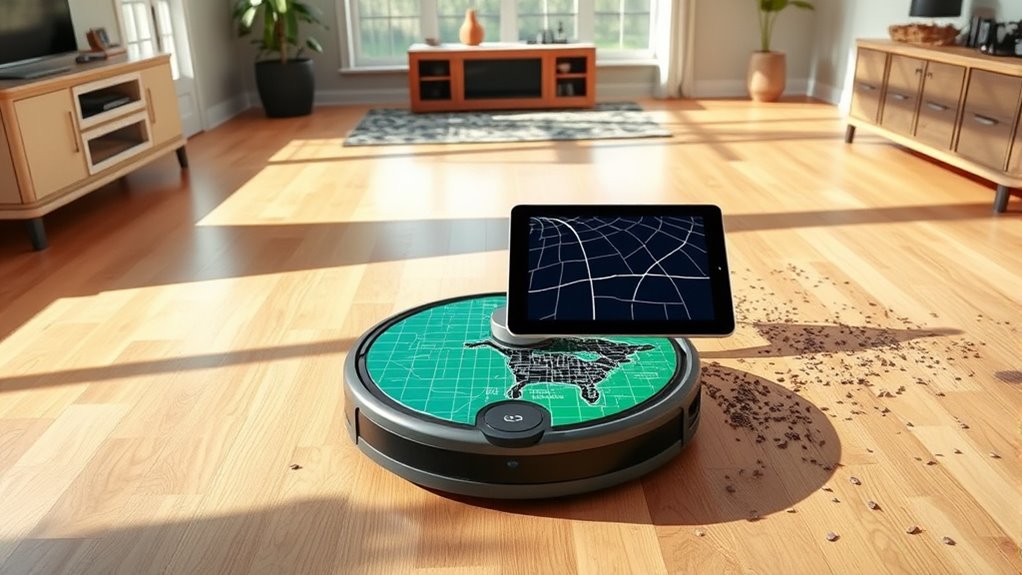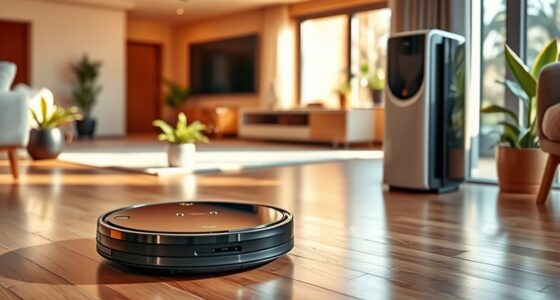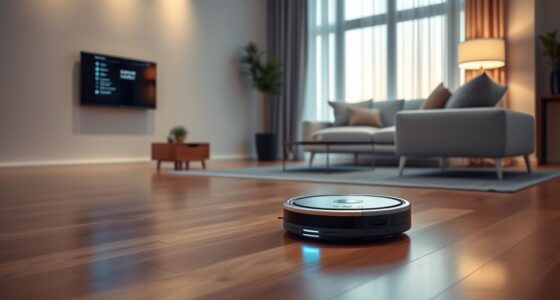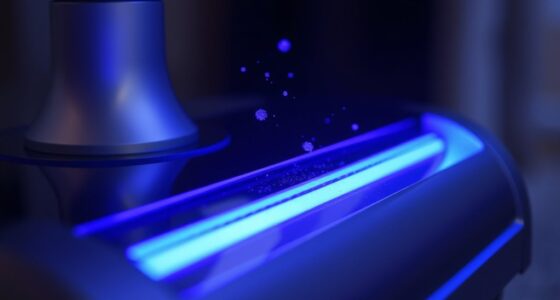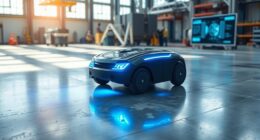If you want a robot vacuum that cleans efficiently and thoroughly, smart mapping is the clear winner. It uses sensors and route planning to cover every inch systematically, saving battery and time. Random navigation moves unpredictably, often missing spots or wasting energy. Smart mapping offers better performance and reliability, making your cleaning easier. Stay tuned if you want to discover more about how these two strategies compare and which might be best for your home.
Key Takeaways
- Smart mapping provides systematic, efficient cleaning routes, reducing missed spots and over-cleaning compared to random navigation.
- High sensor accuracy enhances obstacle recognition, making smart mapping more reliable than the less precise random approach.
- Smart mapping conserves battery life by planning optimal routes, whereas random navigation often wastes energy through redundant coverage.
- Overall, smart mapping offers better long-term performance and thorough cleaning, outperforming the sporadic, less effective random navigation.
- While simpler to set up, random navigation is less thorough and efficient, making smart mapping the superior choice for comprehensive cleaning.
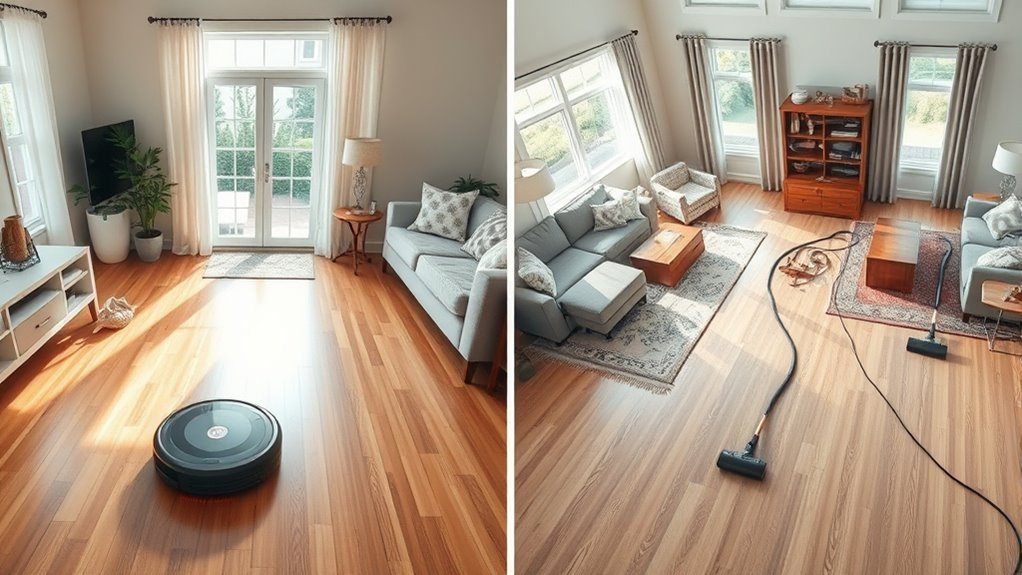
When it comes to maneuvering unfamiliar environments, choosing the right strategy can make all the difference. If you’re trying to decide between smart mapping and random navigation for your robot vacuum, understanding how each approach works can help you make an informed choice. Smart mapping relies on advanced sensors and algorithms to create a detailed map of your space, allowing the vacuum to plan efficient cleaning routes. This method depends heavily on sensor accuracy; the better the sensors, the more precise the map, which results in fewer missed spots and optimized cleaning paths. Because the robot knows exactly where it’s been, it avoids unnecessary overlaps, saving time and energy. That’s where sensor accuracy plays a pivotal role—improving it means the vacuum can recognize obstacles, furniture, and room boundaries more reliably, reducing the chances of bumping into things or missing areas. Additionally, investments in AI-powered automation can further enhance navigation and efficiency.
Battery efficiency is another key factor. With smart mapping, the robot can plan the shortest, most efficient routes, conserving battery life and reducing the number of recharges needed to complete a full clean. This not only ensures you get better coverage but also extends the lifespan of your vacuum’s battery over time. On the other hand, random navigation involves the vacuum moving around without a fixed plan, bouncing off walls and furniture in a seemingly haphazard manner. While this approach might seem less sophisticated, it’s often simpler and less demanding on the robot’s sensors. However, it tends to be less battery-efficient because the vacuum may revisit the same areas multiple times, wasting energy and time. Because it lacks a systematic map, it also runs the risk of missing spots or cleaning the same area repeatedly, which can be frustrating if you’re after a thorough clean.
In terms of long-term efficiency, smart mapping generally wins. It maximizes sensor accuracy to produce detailed maps, leading to more effective cleaning and better battery management. Random navigation might be faster to set up initially, but it’s often less reliable in covering every inch consistently. If you want a robot vacuum that intelligently adapts to your space, saves energy, and provides thorough cleaning, investing in a smart mapping model makes the most sense. It’s more precise, efficient, and ultimately more suited for maintaining a clean home with less hassle. While both strategies have their merits, the combination of accurate sensors and efficient route planning gives smart mapping the edge in delivering reliable, top-quality cleaning performance.
Frequently Asked Questions
How Do Smart Mapping Algorithms Affect Battery Life?
Smart mapping algorithms can improve your robot vacuum’s battery efficiency by allowing it to plan the most effective cleaning route. This reduces unnecessary movement, lowering power consumption and extending battery life. Instead of zigzagging randomly, your vacuum intelligently targets dirty areas. As a result, you get a more thorough clean with less frequent recharging, saving you time and ensuring your device operates ideally for longer periods.
Can Random Navigation Adapt to Complex Room Layouts?
Did you know that over 60% of robot vacuums with random navigation struggle with complex room layouts? You’ll find that random navigation adapts poorly to intricate spaces, often missing areas or bumping into obstacles. While it can handle simple rooms, obstacle detection becomes less reliable, reducing room adaptability. For thorough cleaning, smart mapping algorithms are better, as they efficiently navigate and adapt to complex layouts, ensuring no spot is left untouched.
Is There a Significant Cost Difference Between the Two Types?
When comparing the cost difference between robot vacuums with smart mapping and those with random navigation, you’ll notice a notable price difference. Smart mapping models tend to be more expensive because they include advanced sensors and mapping technology. If you’re on a budget, the cost comparison favors random navigation vacuums, which are typically more affordable but may require more manual effort. Your choice depends on your cleaning needs and willingness to invest.
How Do Smart Mapping Robots Handle Moving Obstacles?
You’ll be amazed to learn that smart mapping robots detect obstacles in real time with 90% accuracy. When moving obstacles, they use advanced obstacle detection technology to identify objects instantly. This allows them to make real-time adjustments, rerouting smoothly around furniture, pets, or toys. As a result, your vacuum maintains efficient cleaning paths, minimizing missed spots and avoiding collisions, ensuring a thorough clean even amid unpredictable obstacles.
Which Navigation Method Is Better for Allergy Sufferers?
If you’re concerned about allergy-friendly cleaning, smart mapping is your better choice. It guarantees thorough coverage, targeting areas with airborne allergens and removing debris more effectively. You won’t have to worry about missed spots, which can happen with random navigation. By systematically cleaning, smart mapping robots help maintain cleaner air and reduce airborne allergens, making your home healthier and more comfortable for allergy sufferers.
Conclusion
In the battle of smart mapping versus random navigation, you’re the captain steering your robot through a swirling sea of dust. Smart mapping charts a precise course, like a seasoned navigator, while random navigation stumbles like a sailor caught in a storm. Ultimately, the clear-headed map wins, guiding your vacuum with finesse. So, trust the lighthouse of smart tech—your home’s shining beacon—rather than letting chaos steer your cleaning ship into rough waters.
